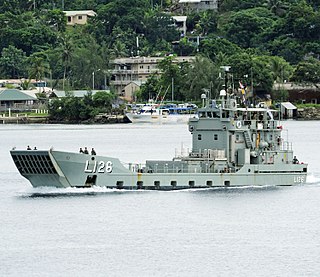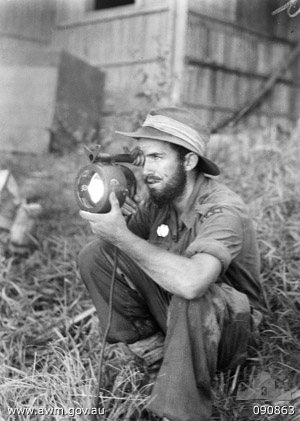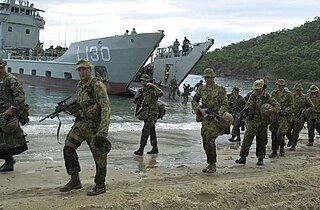
HMAS Balikpapan was the lead ship of the Balikpapan class of heavy landing craft (LCH). Ordered in 1969, Balikpapan entered service with the Australian Army Water Transport Squadron in late 1971. After this, the decision to place all seagoing Army vessels under the control of the Royal Australian Navy (RAN) saw Balikpapan transferred and commissioned in 1974; the last of the eight-vessel class to enter RAN service. Balikpapan was placed in reserve in 1985, but was reactivated three years later. During late 1999 and early 2000, the vessel was part of the INTERFET peacekeeping taskforce, and made additional deployments to East Timor in 2001 and 2006. On 12 December 2012, Balikpapan was retired from RAN service.

HMAS Betano was a Balikpapan-class heavy landing craft operated by the Royal Australian Navy (RAN).

HMPNGS Buna is a Balikpapan-class heavy landing craft operated by the Papua New Guinea Defence Force (PNGDF). Prior to 1974, the vessel was called HMAS Buna and was operated by the Royal Australian Navy (RAN).

HMPNGS Lakekamu is Balikpapan-class landing craft heavy (LCH) operated by the Maritime Operations Element of the Papua New Guinea Defence Force (PNGDF). The vessel was one of eight built for the Royal Australian Navy (RAN) in the 1970s, and was commissioned into the RAN as HMAS Labuan in March 1973. Labuan was decommissioned in November 2014. She was transferred to the PNGDF for use as a training ship and was commissioned as HMPNGS Lakekamu in December 2014.
HMPNGS Salamaua is a Balikpapan-class heavy landing craft operated by the Papua New Guinea Defence Force (PNGDF). Prior to 1974, the vessel was called HMAS Salamaua and was operated by the Royal Australian Navy (RAN).

The Balikpapan class is a ship class of eight heavy landing craft. All eight were originally laid down by Walkers Limited for the Australian Army in the early 1970s. A reorganisation of watercraft responsibilities in the Australian military meant the landing craft were to be operated by the Royal Australian Navy (RAN), with seven commissioned directly into RAN service during 1973 and 1974, and lead ship Balikpapan transferred from the army to the navy. During the leadup to the independence of Papua New Guinea in 1975, two of the vessels were transferred to the new Papua New Guinea Defence Force (PNGDF).

HMAS Tobruk was a Landing Ship Heavy (LSH) of the Royal Australian Navy (RAN), based on the design of the Round Table-class of the British Royal Fleet Auxiliary. Planning for the ship began in the 1970s to provide the Australian Army with a permanent sealift capability. She was laid down by Carrington Slipways in 1979, launched in 1980, and commissioned in 1981. She was a multi-purpose, roll-on/roll-off heavy lift ship capable of transporting soldiers, APCs, and tanks, and delivering them to shore via landing craft or directly by beaching.

HMAS Labuan (L3501) was a Mark III Tank Landing Ship that served in the Royal Navy during World War II, and with the Royal Australian Navy (RAN) from 1946 until 1951.

HMAS Wewak was the fifth ship of the Balikpapan class of heavy landing craft operated by the Royal Australian Navy (RAN).

During World War II the Royal Australian Navy (RAN) formed beach commando units to go ashore with the first wave of amphibious assaults. They would conduct local reconnaissance, signpost the beaches, control boat traffic, and communicate with the maritime forces. These were known as Royal Australian Navy Beach Commandos. They took part in the Borneo campaign.

Walkers Limited was an Australian engineering company, based in Maryborough, Queensland. It built ships and railway locomotives. The Walkers factory still produces railway locomotives and rolling stock as part of Downer Rail.

The Royal Australian Navy and Australian Army have operated 24 amphibious warfare ships. These ships have been used to transport Army units and supplies during exercises and operational deployments.

The BRP Dagupan City (LS-551) is the second and last ship of two Bacolod City class logistics support vessel, and is based on a helicopter capable variant of the US Army Frank S. Besson class. She is also considered one of the most modern transport ships in the Philippine Navy, having been commissioned during the early 1990s. She was previously known as BRP Dagupan City (LC-551) prior to a classification change implemented by the Philippine Navy starting April 2016

The Bacolod City class is a ship class of two Logistics Support Vessels currently in service of the Philippine Navy, commissioned during the early 1990s. These ships were based on a helicopter capable variant of the United States Army's General Frank S. Besson, Jr. class Logistics Support Vessel.

A Landing Craft Vehicle Personnel or Landing Craft, Vehicle, Personnel (LCVP) is any of a variety of amphibious landing craft designed to transport troops or armoured vehicles from ship to shore during amphibious landings.

BRP Batak (LC-299) is a Balikpapan-class heavy landing craft operated by the Philippine Navy. One of eight vessels built by Walkers Limited for the Royal Australian Navy (RAN), the ship was commissioned into Australian service in 1973 as HMAS Tarakan. During her RAN career, Tarakan was deployed post-Cyclone Tracy as part of Operation Navy Help Darwin, undertook various surveying operations, was placed in reserve between 1985 and 1988, relocated an overpopulation of Tridacna gigas clams, was part of the INTERFET peacekeeping taskforce, and participated in a Pacific Partnership humanitarian deployment.
BRP Waray (LC-288) is a heavy landing craft of the Philippine Navy. From 1972 to 2012, it was known as HMAS Betano (L 133) and served the Royal Australian Navy. Betano was decommissioned in December 2012 and stored until it was sold by the Australian government to the Philippine Navy to assist in improving the country's humanitarian and disaster relief capabilities.
The BRP Agta (LC-290) is a landing craft heavy of the Philippine Navy. From 1972 to 2012, it was known as HMAS Balikpapan (L 126) and served the Royal Australian Navy. It was decommissioned in December 2012, was stored until it was sold by the Australian government to the Philippine Navy to assist in improving the country's Humaritarian and Disaster Relief capabilities.
The BRP Iwak (LC-289) is a heavy landing craft of the Philippine Navy. From 1972 to 2012, it was known as HMAS Wewak (L 130) and served the Royal Australian Navy. It was decommissioned in December 2012, was stored until it was sold by the Australian government to the Philippine Navy to assist in improving the country's Humaritarian and Disaster Relief capabilities.
















